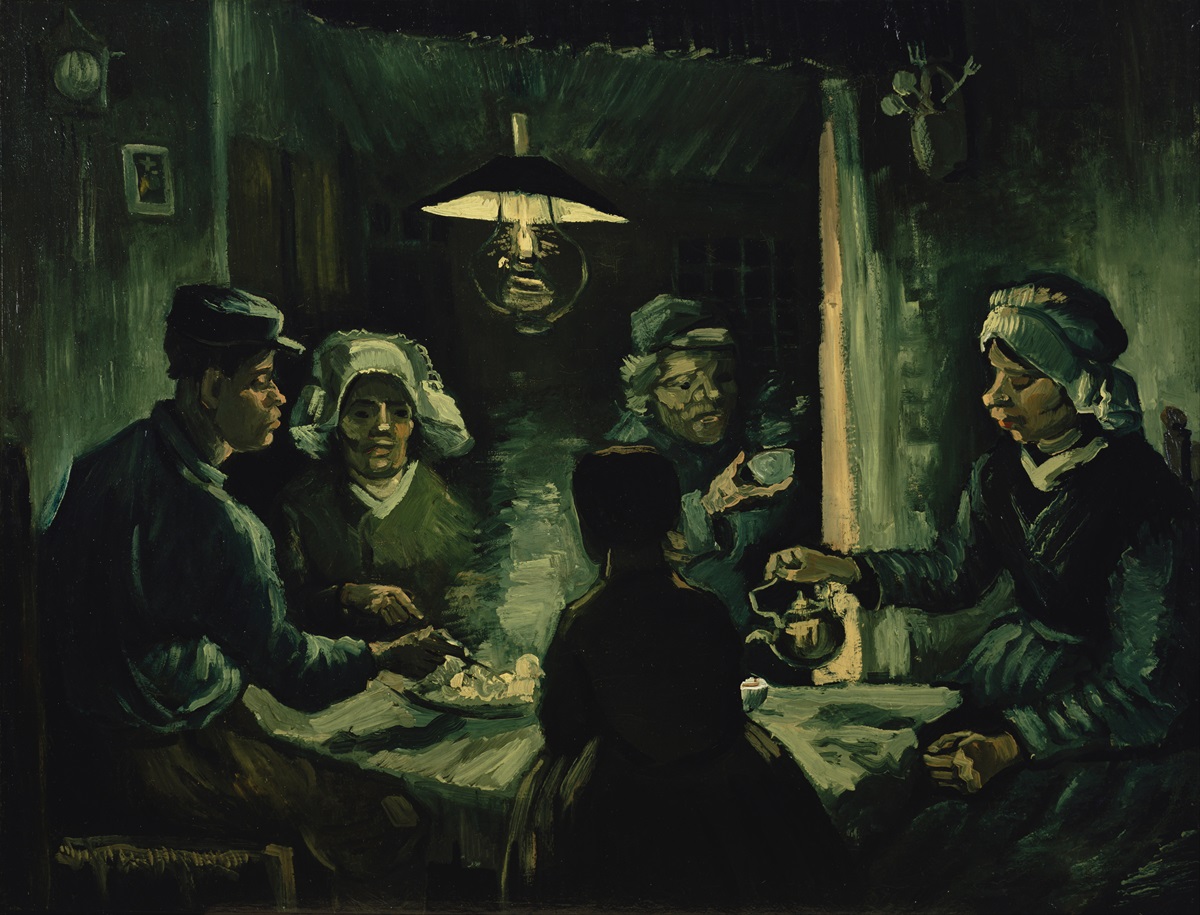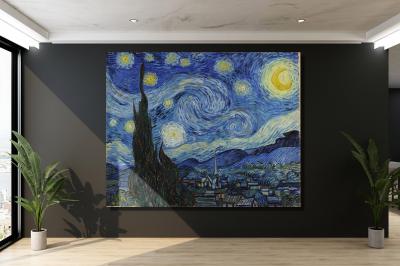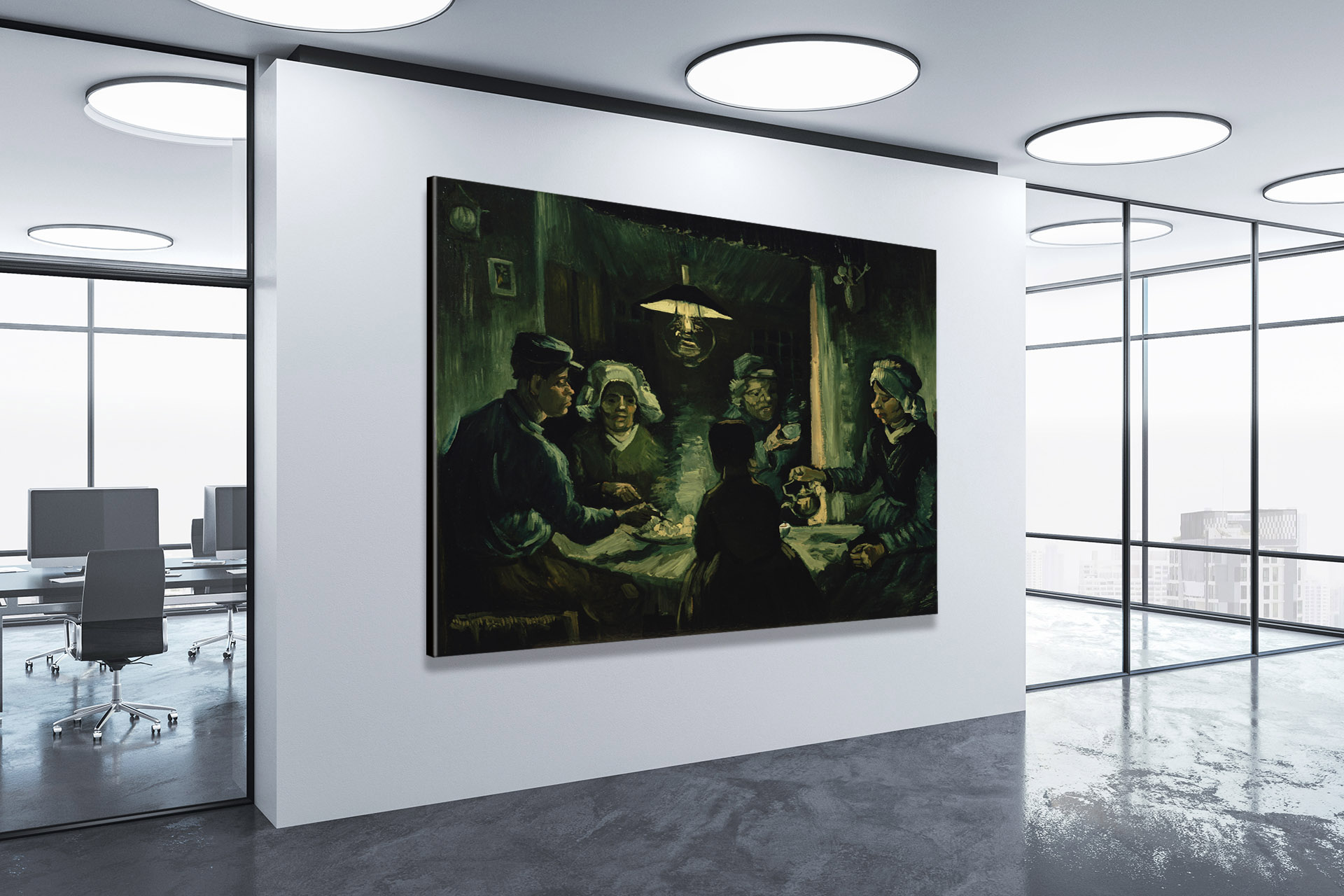The Potato Eaters
By Vincent van Gogh, 1885
Unearthing the Depths of Vincent van Gogh’s “The Potato Eaters”
Vincent van Gogh, an iconic figure in the annals of Western art, is celebrated for his profound ability to capture the essence of human emotion and the exquisite beauty concealed within the ordinary. Amongst his extensive body of work, “The Potato Eaters” emerges as a captivating and enigmatic masterpiece, beckoning us to dive deeper into its historical context, intricate composition, the profound emotions it evokes, the technical challenges van Gogh encountered, the location where this remarkable painting was born, and the artist himself.
The Context
Painted in 1885, “The Potato Eaters” represents a pivotal juncture in Vincent van Gogh’s artistic journey. It was during this period that the Dutch painter resided in the quaint village of Nuenen, an environment that significantly influenced his work. Immersed in the local peasant life, van Gogh sought to depict the raw realities of rural existence, earnestly striving to capture the hardships and inherent dignity of those he observed. This painting is a poignant representation of this period in his career, a time of experimentation and self-discovery.
“The Potato Eaters” Large Canvas Prints from WhiteClouds
Composition and Aesthetic Choices
At first glance, “The Potato Eaters” may appear stark and unpolished compared to some of van Gogh’s later, more renowned works. However, this initial impression belies a profound and deliberate intention. The composition of this masterpiece is dominated by the presence of five peasants huddled around a dimly lit table, partaking in a meager meal of potatoes. The central focus of the painting is undoubtedly the faces of the subjects, which are bathed in a warm, rustic light, casting deep, evocative shadows that imbue the scene with an intimate and almost otherworldly ambiance.
What strikes the viewer most is van Gogh’s meticulous attention to detail. He skillfully captures the coarse textures of the peasants’ clothing, the ruggedness of their hands as they clasp the humble potatoes, and the unadorned nature of their surroundings. The artist’s palette, predominantly composed of earthy tones such as browns and greens, serves to underscore the simplicity and austerity of rural life, drawing the observer even deeper into the heart of this poignant tableau.
Technical Challenges
The creation of “The Potato Eaters” was not without its technical challenges. Van Gogh grappled with the complexities of capturing the harshness and authenticity of the scene while maintaining the integrity of his artistic vision. The play of light and shadow, a hallmark of the painting, required meticulous handling of pigments to achieve the desired effect. Van Gogh’s devotion to realism and his commitment to portraying the ruggedness of the subjects’ features demanded a painstaking attention to detail that tested his skills to the limit.
Location
The choice of location for “The Potato Eaters” is also noteworthy. Nuenen, a small village in the Netherlands, provided van Gogh with the ideal backdrop for his exploration of rural life. It was here that he found the authenticity and inspiration he sought in the daily lives of the local peasants. The setting of the painting, a modest peasant cottage, is a reflection of the rustic charm and simplicity that permeated this agricultural community. Van Gogh’s decision to immerse himself in this environment was pivotal in bringing “The Potato Eaters” to life as a testament to the resilience and fortitude of rural existence.
Emotion and Symbolism
“The Potato Eaters” transcends being a mere representation of peasants sharing a modest meal. Instead, it serves as a profound portrayal of the human condition, rife with emotion and symbolism. The faces of the peasants, etched with lines of toil and adversity, reveal expressions that encompass weariness, stoicism, and a palpable sense of camaraderie. Each countenance tells a unique story, a narrative of lives forged through labor, poverty, and indomitable resilience. Their weathered hands, illuminated by the subdued light, symbolize the strength and endurance required to sustain their humble existence.
Yet, it is the central figure, a woman, whose arresting gaze dominates the composition. Her intense and penetrating expression communicates a quiet determination, as well as a profound sense of responsibility for her family and their well-being. Van Gogh’s deft use of chiaroscuro in rendering her features adds depth and complexity, imbuing her visage with an emotional intensity that is at once haunting and captivating.
Vincent van Gogh: The Artist
Vincent van Gogh, born in 1853, was a Dutch Post-Impressionist painter whose tumultuous life was intertwined with his art. Despite enduring personal struggles and mental health issues, he produced an astonishing body of work in a relatively short span of time. Van Gogh’s unique style, characterized by bold brushwork and vibrant colors, defied traditional artistic conventions and left an indelible mark on the art world.
Van Gogh’s art was deeply influenced by his emotional intensity and his unwavering commitment to portraying the human experience. His works, including “The Potato Eaters,” are marked by a raw honesty and an unflinching examination of life’s complexities. While van Gogh’s life ended tragically in 1890, his artistic legacy endures, continuing to inspire generations of artists and art enthusiasts alike.
 The Potato Eaters by Vincent van Gogh
The Potato Eaters by Vincent van Gogh
Conclusion
In the canon of Vincent van Gogh’s masterpieces, “The Potato Eaters” stands as an extraordinary work that transcends its seemingly unremarkable subject matter. Through meticulous composition, an unparalleled attention to detail, and an ability to evoke profound emotions, van Gogh breathes life into the world of rural peasants in 19th-century Netherlands. This painting is an indelible testament to the artist’s deep empathy for the human condition and his unwavering commitment to authentically capturing life as he perceived it.
As we contemplate this evocative masterpiece, we are reminded of the timeless power of art to traverse eras and locales, inviting us to connect with the universal experiences of humanity. “The Potato Eaters” remains a poignant testament to the resilience, dignity, and unity found even in the most austere circumstances, continuing to inspire and move audiences around the world. In its raw beauty, we discover an enduring confirmation to the profound depth of Vincent van Gogh’s artistic genius and his unrelenting dedication to portraying the essence of life itself, all while overcoming technical challenges and drawing inspiration from the unique location of Nuenen.
Frequently Asked Questions About “The Potato Eaters”
What is the significance of “The Potato Eaters” in Vincent van Gogh’s career? “The Potato Eaters” is significant because it marks a crucial stage in van Gogh’s artistic development. It reflects his early interest in depicting the lives of peasants and his commitment to realism.
Who are the people depicted in “The Potato Eaters”? While the exact identities of the subjects are not known, they are believed to be local peasants from the village of Nuenen, where van Gogh lived at the time.
What is the story or narrative behind “The Potato Eaters”? “The Potato Eaters” portrays a group of peasants sharing a simple meal, emphasizing the hardships and solidarity of rural life. The painting captures a moment of togetherness and resilience.
Why did van Gogh choose to depict peasants eating potatoes? Van Gogh was deeply inspired by the rural life he encountered in Nuenen. He saw the peasants as authentic and noble subjects, and he believed that by portraying their everyday struggles, he could convey the dignity of their lives.
How did van Gogh create the unique lighting and atmosphere in “The Potato Eaters”? Van Gogh achieved the distinctive lighting through a technique called chiaroscuro, using strong contrasts between light and shadow. This technique added depth and emotional intensity to the painting.
What was the critical and public reception of “The Potato Eaters” when it was first exhibited? “The Potato Eaters” was not well-received by art critics and the public when it was first exhibited. Some found it too somber and lacking in the vibrant colors that van Gogh would later become known for.
Where can “The Potato Eaters” be viewed today? “The Potato Eaters” is currently housed at the Van Gogh Museum in Amsterdam, Netherlands, making it accessible to art enthusiasts and visitors from around the world.
How does “The Potato Eaters” compare to van Gogh’s later, more famous works? “The Potato Eaters” differs from van Gogh’s later works in its darker, more subdued palette and its focus on rural realism. His later works are often characterized by brighter colors and more expressive brushwork.
What inspired van Gogh to explore peasant life and rural subjects? Van Gogh’s decision to explore peasant life was influenced by his desire to connect with the lives of common people and his fascination with the authenticity and dignity he found in rural communities.
What is the current value or estimated worth of “The Potato Eaters”? While the value of “The Potato Eaters” is immeasurable in terms of its artistic significance, it is considered priceless and not available for sale. However, some experts estimate its theoretical value to be in the hundreds of millions of dollars, given the importance of the painting in art history.
Other Articles on Vincent van Gogh Paintings
At Eternities Gate by Vincent Van Gogh, 1890
Blossoming Almond Tree by Vincent Van Gogh, 1890
Cafe Terrace at Night by Vincent Van Gogh, 1888
Daubigneys Garden by Vincent Van Gogh, 1890
Green Wheat Field with Cypress by Vincent Van Gogh, 1889
Houses at Auvers by Vincent Van Gogh, 1890
Irises by Vincent Van Gogh, 1889
Night Café by Vincent Van Gogh, 1888
Portrait of Dr. Gachet by Vincent Van Gogh, 1890
Red Vineyards by Vincent Van Gogh, 1888
Road with Cypress and Star by Vincent Van Gogh, 1890
Starry Night by Vincent Van Gogh, 1889
Starry Night over the Rhone by Vincent Van Gogh, 1888
Sunflowers by Vincent Van Gogh, 1887
The Bedroom by Vincent Van Gogh, 1888
The Church at Aurers by Vincent Van Gogh, 1890
The Garden of the Asylum by Vincent Van Gogh, 1889
The Mulberry Tree by Vincent Van Gogh, 1889
The Potato Eaters by Vincent Van Gogh, 1885
The Yellow House by Vincent Van Gogh, 1888
Tree Roots by Vincent Van Gogh, 1890
Van Gogh Self Portrait by Vincent Van Gogh, 1887
Vase with Red Poppies by Vincent Van Gogh, 1886
View of Arles by Vincent Van Gogh, 1889
Wheat Field with Crows by Vincent Van Gogh, 1890
Wheat Field with Cypresses by Vincent Van Gogh, 1889
More WhiteClouds Videos
Contact us today to learn more about our 3D services and how we can help you achieve your goals.

